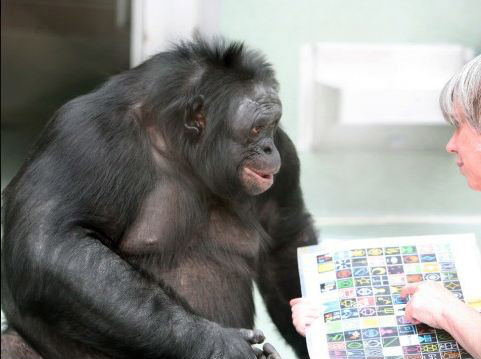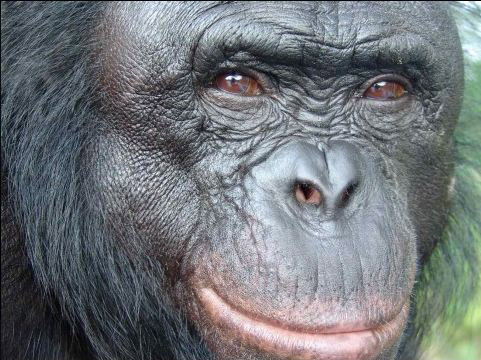Bonobo Diaries: A Conversation With Sue Savage-Rumbaugh

Kanzi communicates with Dr. Sue Savage-Rumbaugh using lexigram panels. Photo courtesy of Liz Rubert-Pugh.
It's three hours until my flight to Uganda, where I will visit sanctuaries and learn about conservation efforts before crossing overland into Rwanda, then into the Congo. At the moment, I'm in Doha. I arrived this morning from Paris and, with nineteen hours between flights, I hired a taxi to show me around. It was difficult not to compare what I knew awaited me in the Congo to the excesses I was seeing: SUVs and luxury cars, Hummers and BMWs, and the showcase of skyscrapers—sleek, modern constructions fused with Islamic facades, pointed arches in Westerner high rises, arabesques embroidering the edges.
Yesterday, before leaving Paris, I spoke to Dr. Sue Savage-Rumbaugh, the primatologist whose work on language capacity in apes, particularly bonobos, earned her a place on Time's 2011 list of the 100 most influential people in the world. Surprisingly, shortly after receiving this honor, she lost the funding to continue her work. For more than three and a half decades, she has studied apes—first chimpanzees, then bonobos—to see how they use language. The work was challenging, until Kanzi, a baby bonobo who observed the language lessons that his adoptive mother, Matata, suffered through, suddenly demonstrated that he was learning English naturally, the way human children do. Given that a bonobo's vocal cords are not suited to human language, he communicated using a sheet printed with symbols. When a symbol was lacking, he improvised, asking for pizza by pointing to "cheese," "tomato" and "bread." He's been on CNN and Oprah, and is listed as a public figure on his Facebook page. I met him last April, and he studied me closely, as if to determine just how interesting this encounter might be. After all, he'd played music with Paul McCartney and Peter Gabriel.
When I spoke with Savage-Rumbaugh, I wanted to discuss how bonobos can serve as a flagship species for the rainforest, and I told her the question I most often hear—that many conservationists hear—"Why bonobos? What makes them interesting?" At first, she answered simply: "In terms of anatomy, genetics and personality, bonobos are the most humanlike of all apes." But then, after a moment, she explained that in bonobos, "it is love and the rearing of children that holds the group together. Bonobos are the only great apes that live in large tribes in the Congo, and they most closely touch the origins of humankind... We still carry so much genetic heritage that's in common with the bonobo that only by studying them can we have any inkling of what might actually have happened in the past."
"And this is more true of bonobos than of Chimpanzees?" I asked.
"When the data is fully in," she told me, "I think that it will be seen that bonobos are more fully related to humans in how their genes express themselves."
For those who know little about bonobos, there's a reason: they live only in the Democratic Republic of the Congo, far from the coastline, and, because of their isolation and resemblance to chimpanzees, were the last great ape identified as a distinct species. Until recently, they received little media attention and lacked vocal champions like Jane Goodall, Diane Fossey and Birute Galdikas. They were nicknamed the "hippies of the forest" because they love sex and have never been witnessed killing each other. Unlike chimps, they mate face-to-face, gazing into each other's eyes; they enjoy oral sex and French kissing, and are bisexual. This behaviour is, of course, seen through the lens of human sexuality, and researchers often disagree as to its value for bonobos. What appears certain, however, is that, for comfort and reconciliation, they rely on frequent genital rubbing, which can take place with all combinations of partners in a group. They are also largely matriarchal, with females forging alliances that determine the ranks of the males.
However, this is the sort of information gleaned from field observation, and there's a line between what we can learn as scientists and what we learn by actually living with another creature. Savage-Rumbaugh has lived with bonobos for over three decades, attempting to take part in their culture while they have studied hers, and I asked what that had taught her.
"Freeing oneself absolutely," she said, "from any thought or tendency towards aggression, and focusing on group love and cohesion—and I don't mean sex, I mean love—is the way of the bonobos. It's a message that humanity needs to try to understand."
"But don't they have conflict the way we do?" I asked, and she acknowledged that they did, often behaving like humans by screaming at each other and showing off their strength. "But," she added, "they tend to try to find ways not to actually harm each other. They search for that... [Working with bonobos has] given me a perspective on humanity, a perspective on myself that I could never otherwise have had."
She continued, "Jane Goodall changed humanity's view of itself when she revealed through her efforts with National Geographic that humankind shared a feeling world with chimpanzees... [With Kanzi] it has been shown that truly for the first time there are other animals on the planet that can share a language, intellectual, thinking world with human beings. You put those two together, and you have to ask what is human. So Kanzi is stretching the definition of human. He's forcing a redefinition of what humanity means. And that for some is intriguing and fascinating. For others, it is very uncomfortable. In part, you can be influential because you upset the social system. Kanzi upsets the social norm."

Kanzi in 2006. Photo courtesy of Liz Rubert-Pugh.
As I mentioned in my previous blog entry, the bonobos live in rainforests vital for the purification of the atmosphere, and what could be a better symbol of those forests than a creature that, in many ways, symbolizes our better selves and our ability to transform? And yet our increased awareness of bonobos has begun at a time of financial crisis. Even Savage-Rumbaugh has lost funding that, compared to the massive expenditures of governments and wealthy citizens, is very little. I am writing this from Doha after all, a few hours after having taken a taxi through the Pearl, a four-million-square-metre artificial island of luxury villas, five-star hotels and very expensive boutiques. I can't help but consider that humans often conflate personal transformation with the acquisition and exhibition of wealth, and no doubt, in a rampantly capitalist world, money offers the clearest path to some sort of change. But if Time acknowledged the importance of Savage-Rumbaugh's work, it was because of what it says about the deeper power of our dynamic nature: that what we consider human can shift drastically, just as Kanzi is learning across cultures and expanding his notion of self.
"The important aspect of that message is that humanity isn't stuck in the current rut," Savage-Rumbaugh told me. "We might consider ourselves a naked ape, but we have the capacity to be, let's say, a godlike ape. We can do far more than we're doing. We have limited ourselves and our understanding of our biology—our understanding of how we must structure the world—by the past. And we don't have to continue to do that. If Kanzi can learn a language, what can human beings learn that we haven't learned yet? We can certainly learn how to get along."
At first, when I heard her say "a godlike ape," I was surprised, and yet it's nothing that many of us haven't often thought. We value those with transformative powers and mastery; it's why we constantly tell ourselves stories of anything even slightly superhuman. Ironically, despite what Savage-Rumbaugh is teaching us, her bonobos could be split up within two or three months, each of them sent to whatever different institutions would accept them.
"Is there any last thing you would want to tell someone about bonobos?"
Savage-Rumbaugh hesitated for a long time.
"That," she said, "that we're just on the cusp of really understanding how brains interact, brains between species and human brains within a given body. We have thought of ourselves as individual sacks of skin. We're far more connected than we've ever understood. And bonobos have almost a sixth sense. They have an understanding of their connectedness. And when we are able to finally grasp and measure that scientifically, I think we'll be able to know what it means when we say humans have vibes or humans react with each other. I don't think that's just a phrase. I think there's something going on that's really happening between us, but that linguistically we have, through our culture, shut out. And bonobos haven't shut that part of themselves out. So I just want people to realize that we're just on the cusp of understanding the most fascinating species on the planet—not that elephants and dolphins and others aren't—but we're on the cusp of understanding that species and we're about to decimate it in the Congo and we're about to let the special group that we have here, that has language skills and can talk to us, disappear."
Learn more about Sue Savage-Rumbaugh's work at bonobohope.org. For information about bonobo conservationism, visit bonobo.org.
Deni Y. Béchard's first novel, Vandal Love, won the Commonwealth Writers' Prize. Over the next several months, he will blog for Maisonneuve regularly from central Africa as he researches his new book. Track him online here with a satellite GPS tracker. His travel updates and reading habits are on Twitter at @denibechard.
Subscribe to Maisonneuve today.
Related on maisonneuve.org:
—Bonobo Diaries: Why I'm Writing a Book About the Congo
—Sink or Swim
—Waste Not





